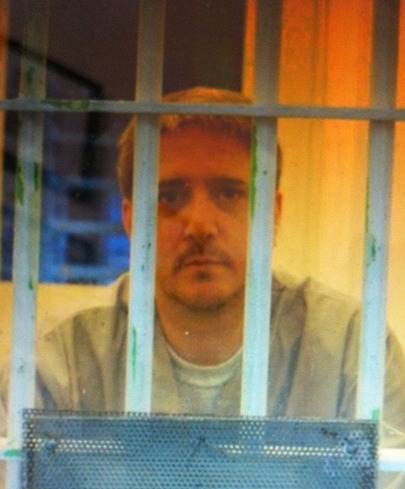aNewDomain — So far, luck’s been on the side of death row inmate Richard Glossip, who avoided execution at the hands of the State of Oklahoma again last week.
This time, OK Governor Mary Fallon, not the court, ordered a stay, just minutes before he was scheduled to die by lethal injection for a murder no court has ever said he personally committed. Indeed, a growing number of supporters, like those gathering in Washington, D.C. this week to protest his execution, believe he might not be guilty of planning the murder of an Oklahoma City hotel clerk either. Witnesses have come forward to say that another man, the man who admitted he was the one who killed the victim during Glossip’s trial, framed Glossip. They have yet to be heard.
 But the stay wasn’t ordered on grounds that there should be an evidentiary hearing to review new evidence. Rather, Gov. Fallon said it had to do with one of the drugs ordered for the lethal cocktail. And that only highlights, Glossip’s supporters say, how ill-equipped Glossip’s executioners really are.
But the stay wasn’t ordered on grounds that there should be an evidentiary hearing to review new evidence. Rather, Gov. Fallon said it had to do with one of the drugs ordered for the lethal cocktail. And that only highlights, Glossip’s supporters say, how ill-equipped Glossip’s executioners really are.
After Fallon stayed the September 30 execution of Glossip at the eleventh hour due to reservations about the state’s lethal injection drug protocol, we should note, OK Attorney General Scott Pruitt followed suit and announced he was seeking an indefinite stay of all scheduled executions in the state.
The Mystery of The Mystery Cocktail
The drug used for execution is supposed to be Potassium Chlorinate, but the state received Potassium Acetate. That might be sufficient to kill a man, innocent or guilty, but it isn’t protocol and it was the wrong drug to order. So why did that drug end up in the death chamber? Oklahoma Department of Corrections Officer Alex Gerszewski reportedly attempted to answer this question in an email to Time, saying: “I still don’t know why we had Potassium Acetate … we can’t discuss how we obtain the drugs.”
In an effort to calm this perfect storm, Pruitt sat down with The O’Collegian yesterday evening, the student newspaper of Oklahoma State University, to address the growing controversy now surrounding the indefinite stay of not just Glossip’s execution but also those of other Oklahoma death row inmates scheduled to die. The Department of Corrections “advised my office and the governor’s office very late in the process barely an hour before the execution that they had received the wrong drug,” Pruitt said, adding:
We have three different drug protocols — three different options involving different drugs. Potassium chloride is one of the drugs that is used in each of those protocols, and Potassium Chloride has been used by the state for a long time.”
As Potassium Acetate is not part of the protocol, you’d think that, on delivery about two hours prior to Glossip’s scheduled execution, officials would’ve gotten the wheels turning on delaying the execution. Reportedly, though, they briefly considered whether to improvise and use an improper drug again.
 It’s worth noting that state law here attempts to remove any ambiguity about the cocktail: Officials must notify the condemned and identify the specific substances in the protocol “in writing 10 calendar days prior to the scheduled execution date.”
It’s worth noting that state law here attempts to remove any ambiguity about the cocktail: Officials must notify the condemned and identify the specific substances in the protocol “in writing 10 calendar days prior to the scheduled execution date.”
Oklahoma’s lethal injection cocktail recipe had been secret since the state resumed executions years ago. It became public only after a United States Supreme Court’s ruling in June, which upheld the constitutionality of the lethal injection protocol. Moreover, it affirmed that the current drug concoction includes Potassium Chloride, Rocoronium Bromide and Midazolam. Midazolam is the controversial sedative at the center of the recent Supreme Court case due to the history of other botched executions using the drug.
Oklahoma AG Pruitt called the late notice about the misordered drug troubling at best:
So, for the DOC to advise my office that late in the process that they had received Potassium Acetate as opposed to Potassium Chloride is very troubling and it’s something we’re investigating and inquiring into now to see how that happened.”
 Glossip supporters have been quick to note how consistent Pruitt’s statement is with the defensive tone of DOC Director Robert Patton, who blamed the state’s drug supplier for the mix-up. Like him, Pruitt has also shifted blame to the provider.
Glossip supporters have been quick to note how consistent Pruitt’s statement is with the defensive tone of DOC Director Robert Patton, who blamed the state’s drug supplier for the mix-up. Like him, Pruitt has also shifted blame to the provider.
But the responsibility for verification of receipt of the substances has nothing to do with the provider. It is incumbent upon the DOC two days prior to the execution, pursuant to internal penal procedure, which would have happened on Monday, September 28.
Pruitt also said:
How did the pharmacist send the wrong drug, why did they send the wrong drug … that process is ongoing and it’s something that as far as my office is concerned, we have litigated successfully the use of Midazolam, the Supreme Court said that was constitutional, and we’ve also litigated the execution protocol which is just the procedures that the DOC has to go through in carrying out the death penalty.”
But wasn’t it the state that failed to comply with its own procedures in a death case, even after the Court approved the controversial drug, Midazolam? And wasn’t it the state that in turn managed to bungle the execution protocol with an incorrect Potassium metabolite? Those are the questions Glossip supporters specifically and death penalty opponents in general want answers to now.
“It is mind-boggling that a state could get something this basic wrong in a high-profile execution following a Supreme Court challenge to a state’s execution protocol,” says Robert Dunham, who is executive director of the Death Penalty Information Center. He added:
There is no excuse for a state to be so unprepared to carry out an execution.”
These disturbing circumstances recall the reckless origins in the gruesome execution in Oklahoma of Clayton Lockett, whose execution was botched last year because the drugs “weren’t working as they were designed to,” as a state spokesman said at the time. Witnesses reported Lockett “had been mumbling, bucking, and clenching his jaw. He died of a heart attack 40 minutes after the botched execution began.”
Why carry out executions time after time with fatal flaws in its process with cryptic protocols for indefinite periods? And why the rush to execute Glossip in any case? It’s a final solution in the face of new evidence that’s come to light. Especially considering the fact that the Oklahoma City forensic scientist whose findings put Glossip at the scene has been thoroughly discredited and shown to have sent 10 innocent men to death row during her tenor, there are too many doubts to rush to such a permanent punishment. Glossip, if he is guilty, is safely behind bars after all, and has been for the last 18 years. But if he’s innocent, do Fallon and the rest of them really want the blood of an innocent man on their hands?
This is the tone of the Glossip protests we are all hearing more and more about, especially the one this week in Washington, D.C. (Pictured two images above.)
Shadowed Drugs
In Glossip’s case, the latest stay resulting from lethal injection recipe bunglings arrives after agonizing months and years of national headlines blaring about innocence and guilt, constitutional issues, serious prosecutorial misconduct, mishandled forensics, ineffective trial and appellate defense counsel and, most recently, allegations of the state’s tampering with defense witnesses who’ve tried to come forward to espouse Glossip’s innocence.
Especially given the embarrassments and outright torture involved in the last Okahoma execution, questions are being raised about the effectiveness of the execution protocol in any case. Consider, for instance, Oklahoma’s 2011 privacy law. The administration of executions reads:
The identity of all persons who participate in or administer the execution process and persons who supply the drugs, medical supplies or medical equipment for the execution shall be confidential and shall not be subject to discovery in any civil or communal proceedings.”
Might this result from drug companies wanting to distance themselves from the executioner’s mask? Business Insider posted a story that stated:
In some states, including Oklahoma, compounding pharmacies (which are not regulated by the Federal Drug Administration) create customized forms of lethal injection drugs with the products available to them, the National Journal has reported. However, states have kept those businesses anonymous because those entities shy away from attention of any public link to the death penalty.”
 Federal Public Defender Dale Baich, who served on Glossip’s team in the June Supreme Court challenge and for other prisoners involving the disputed sedative, Midazolam, reported that his team received an August 11 correspondence confirming that the DOC had in custody “sufficient drugs” to administer the scheduled executions of Glossip as well as other death row inmates scheduled to be put down in October.
Federal Public Defender Dale Baich, who served on Glossip’s team in the June Supreme Court challenge and for other prisoners involving the disputed sedative, Midazolam, reported that his team received an August 11 correspondence confirming that the DOC had in custody “sufficient drugs” to administer the scheduled executions of Glossip as well as other death row inmates scheduled to be put down in October.
John D. Hadden wrote that the drugs “are manufactured and not compounded … and none of the drugs will expire prior to the current execution dates of these three inmates.”
Whether the substances at issue are drugs or compounds is relevant to issues of transparency because compounds are not regulated as strictly as chemicals the FDA classifies as pharmacological “drugs.” Also at issue is whether the public has a right to know whether to choose to boycott or protest drug or compound manufacturers, such as they have and do in other protests involving life and death and public policy issues.
According to The Miami Herald, drug content secrecy laws and policies extend from Oklahoma to Louisiana, Georgia, Missouri, and Texas, all of which can hide the content of lethal injection compounds.
Oklahoma, it’s worth noting, is among a confederation of states with laws allowing its prison bureaus to prohibit the source where they obtain execution drugs.
Capital punishment expert Deborah Denno told the National Journal this shows an absence of state transparency and the ineffectiveness of the state penal system, saying:
They choose drugs because they are available, not because they know anything about those drugs.”
Death on The Half Shell
To many, the grave series of errors in the Glossip case raises questions. Big questions. For instance, Oklahoma citizens are now publicly wondering whether the administration of justice through execution can ever be conscientiously imposed. States continue to struggle to carry out lethal injection effectively, after all. In such states as Oklahoma, Arizona, Nebraska and Texas, the ordering, shipping, receiving, and correctly identifying the compounds of death is mangled time and again.
The current death penalty abolitionist’s so called “transcendence” of respecting human dignity over delivering death as punishment looks is in the air. US Supreme Court Justice Antonin Scalia’s recently expressed his own belief that the death penalty may be going away. That perhaps is merely a nod to his colleague, Justice Steven Breyer, who delivered a powerful dissent in the Glossip ruling. Or maybe it is more. Time will tell.
The entire Glossip’s debate following the June Supreme Court ruling would never have happened had the majority followed the stirring voice of Justice Stephen Breyers’s dissenting opinion. Breyes spoke to spare Glossip’s life because, he wrote, lethal injection constitutes cruel and unusual punishment. And only Justice Breyer would have saved Glossip in the defense team’s final appeal to the High Court, shortly before the September 30 execution was scheduled to take place.
 In due course, the resonance of Justice Breyer’s voice may herald the chorus and usher in a new era for the judiciary to abolish the death penalty as unconstitutional.
In due course, the resonance of Justice Breyer’s voice may herald the chorus and usher in a new era for the judiciary to abolish the death penalty as unconstitutional.
Since 2007, Illinois, Maryland, New Mexico and New Jersey have abolished the death penalty.
Earlier this year, conservative Nebraska legislatively relented to the abolition movement, a triumph of transcendence, and banned the death penalty and defied a gubernatorial veto.
Likewise, this August the Connecticut Supreme Court ruled the death penalty unconstitutional and barred all executions of inmates on death row.
Some pundits on the Hill have speculated that a better candidate for the Supreme Court to consider the death penalty issue arises from the US Court of Appeals for the Ninth Circuit. In that case, a federal district judge has already declared California’s death penalty unconstitutional because of long delays, inadequate funding for defense lawyers and the lack of a lethal injection protocol.
Openness to the idea of abolition was represented in Newt Gingrich’s reconsidered stance on the issue in “the light” of Pope Francis’ statement to Congress regarding the death penalty. Gingrich served as House Speaker when Congress passed the Antiterrorism and Effective Death Penalty Act (AEDPA), which limited the availability of federal judicial review of death sentences imposed in the state courts. Now he is singing a different tune.
“We need to profoundly rethink what we’ve done over the past 25 years in criminal justice,” Gingrich observed.
For aNewDomain, I’m Jim Kelly.
All Rights Reserved; Scott Pruitt via Wikimedia Commons; Stephen Breyer via Wikimedia Commons. Richard Glossip execution protest in Washington on Tuesday, Oct. 6, 2015: MoveOn.org and The Washington Post, All Rights Reserved.













